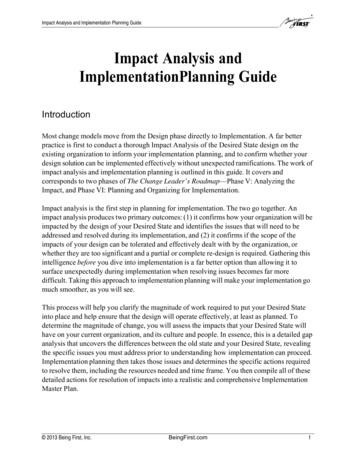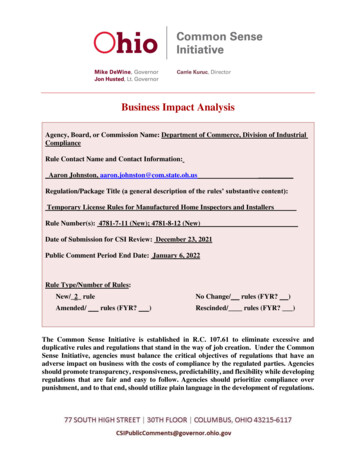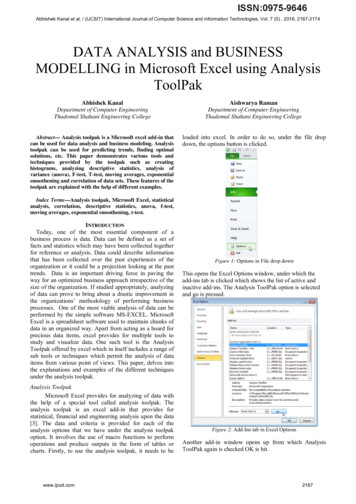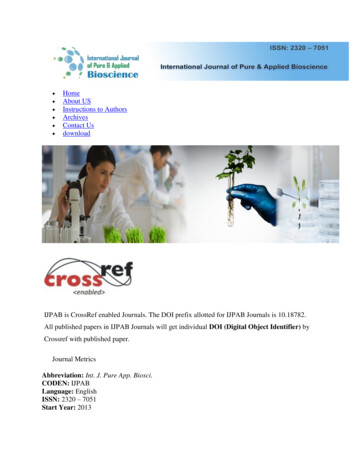
Transcription
Impact Analysis and Implementation Planning GuideImpact Analysis andImplementationPlanning GuideIntroductionMost change models move from the Design phase directly to Implementation. A far betterpractice is first to conduct a thorough Impact Analysis of the Desired State design on theexisting organization to inform your implementation planning, and to confirm whether yourdesign solution can be implemented effectively without unexpected ramifications. The work ofimpact analysis and implementation planning is outlined in this guide. It covers andcorresponds to two phases of The Change Leader’s Roadmap—Phase V: Analyzing theImpact, and Phase VI: Planning and Organizing for Implementation.Impact analysis is the first step in planning for implementation. The two go together. Animpact analysis produces two primary outcomes: (1) it confirms how your organization will beimpacted by the design of your Desired State and identifies the issues that will need to beaddressed and resolved during its implementation, and (2) it confirms if the scope of theimpacts of your design can be tolerated and effectively dealt with by the organization, orwhether they are too significant and a partial or complete re-design is required. Gathering thisintelligence before you dive into implementation is a far better option than allowing it tosurface unexpectedly during implementation when resolving issues becomes far moredifficult. Taking this approach to implementation planning will make your implementation gomuch smoother, as you will see.This process will help you clarify the magnitude of work required to put your Desired Stateinto place and help ensure that the design will operate effectively, at least as planned. Todetermine the magnitude of change, you will assess the impacts that your Desired State willhave on your current organization, and its culture and people. In essence, this is a detailed gapanalysis that uncovers the differences between the old state and your Desired State, revealingthe specific issues you must address prior to understanding how implementation can proceed.Implementation planning then takes those issues and determines the specific actions requiredto resolve them, including the resources needed and time frame. You then compile all of thesedetailed actions for resolution of impacts into a realistic and comprehensive ImplementationMaster Plan. 2013 Being First, Inc.BeingFirst.com1
Impact Analysis and Implementation Planning GuideThe following diagram portrays the flow of events in the entire Impact Analysis andImplementation Planning process, culminating in an approved Implementation Master Plan. Thegraphic lays out three distinct sets of activities to get the Phase V and VI work done, includingtwo 1½ days working sessions and a series of actions that occur in between those sessions.The information and resources in this guide support this entire body of work, outlining eachsession and providing tools to assist you to complete the work of each step in the process.Worksheets are provided throughout the guide. You may wish to tailor these to fit theinformation you choose to gather, combine them into a longer, master worksheet, or create adatabase file of consolidated worksheets. Review the entire guide before beginning, noting howyou will tailor the guidance to fit your specific needs.Also, in support of your thinking and execution of this work, be sure to review all the Tools andInfo Sheets in Phase V and VI of The Change Leader’s Roadmap, especially the Tool:Designing Impact Analysis Process. You will find this tool in Task V.A.1, Design Process forConducting Impact Analysis. This Tool will help you to further clarify how to get this workdone.2BeingFirst.com 2013 Being First, Inc.
Impact Analysis and Implementation Planning GuideImpact Analysis and ImplementationPlanning Process 2013 Being First, Inc.BeingFirst.com3
Impact Analysis and Implementation Planning GuideSession 1Impacts and MagnitudeThe goal of this working session is to identify the impacts of your Desired State design on yourcurrent organization and to assess the magnitude of change involved in this effort. There arethree main activities in this session:1. Identify impacts. You may have identified Impact Topic Areas to study in advanceof this session, or do it early in this session.2. Cluster impacts into groupings or categories, integrate them as much as possible, andassign them to leaders for resolution.3. Prioritize the issues through a magnitude assessment and get organized for theintegration and resolution process.The work of this session may reveal critical issues that can derail your success, called “showstoppers.” If you identify show-stoppers, you must go back to the Design phase, adjust yourDesired State design, and then host a fresh “Session 1” meeting to perform a new impactanalysis process on your refined design.We will review each of the three main activities of Session 1. Use the worksheets that follow toguide your work. You will need to engage the right people to accomplish these activities, anddesign the best process to do so in your actual working session.1. Identify ImpactsThe work of analyzing impacts begins with honing in on the priority Impact Topic Areas mostrelevant to your Desired State. These topics can be identified using the Worksheet: DeterminingYour Impact Topic Areas. The lists in this worksheet address two areas to focus on to generatedetailed impact issues: (1) the CONTENT of your change effort, or the formal organization,including structures, management systems, business processes, skills, numbers of people,technology, work practices, and so on; and (2) the PEOPLE topics: the human and culturalaspects of your organization, including Human Resources systems and processes, plus mindset,behavior, relationships, and all elements of culture. You will assess these areas by comparingthem between what is called for by your future state design and the way the larger systemcurrently operates. You may also want to consider how they are described in your Desired Stateto see if they are clear and complete.4BeingFirst.com 2013 Being First, Inc.
Impact Analysis and Implementation Planning GuideThis part of the process is your gap analysis. If your current state already achieves or supportsthe needs of your Desired State, there is no issue to resolve. If you identify conflicts betweenyour current organization and your future state design, gaps between your current state andyour future state, issues that need further exploration, or simply questions, then you have an“impact” that needs attention and resolution. You may find it useful to frame your impactsusing the question, “How do we ?”This Phase V impact analysis differs from the initial impact analysis you performed when youbuilt your Case for Change in Phase I. Your initial impact analysis was based on yourconceptual future state. It provided information about the general magnitude of yourtransformation for determining its scope. Now that you have created a precise picture of whatyour new state will be and how it will need to operate (your design solution), you will perform amore comprehensive impact analysis with which to plan for its implementation.After you have filled in the Worksheet on Determining Your Impact Topic Areas, you maywant to scan your input from the tool you used to do your initial impact analysis (see Tool:Performing an Initial Impact Analysis) back in Phase I, Case for Change.Here is a sample list of impacts to help you see the types of issues that may surface in yourimpact analysis: How will we reduce the organizational structure by one layer of management How will we consolidate products “X and Y” for ease of sale and delivery to customers How will we redesign the resource allocation process How will we build stronger and more sustainable customer relationships and culturalnorms in the sales operation How will we broaden the “ABC” family of products (for example, acquisition or in-housestart-up) How will we overcome the attitude of entitlement in the Research and Developmentdepartment How can we redesign the reward system to motivate greater team performance and reduce“rugged individualism”Identification of your Impact Topic Areas will help to scope what to study in Session 1. TheWorksheet: Scope of Your Impact Analysis, provides questions to assist. Use the Worksheet:Determining Your Impact Topic Areas to further define the areas you will study.When you have determined and prioritized your Impact Topic Areas, you will assign them tothe best people to perform the detailed impact analysis to identify the specific issues,challenges, or questions you have about each topic are. All of these detailed impacts will thenbe worked in the next step. 2013 Being First, Inc.BeingFirst.com5
WORKSHEETScope of Your Impact Analysis1. Identify the parts of your organization to include in your impact analysis. (e.g., departments, functions, product or service lines, regions, and so on). Correlate these to whatis in the design of your Desired State.2. Clarify any boundary conditions, what is out of scope, or must be kept “as is” in thefuture state.6BeingFirst.com 2013Being First, Inc.
WORKSHEETDetermining Your Impact Topic AreasContent/Organizational Topics Visioning process Governance and decision-making (by individuals, committees, functional groups inthe organization); approval processes/authority levels Financial controls: budgeting, accounting procedures, record-keeping formats,capital investment criteria, processes, etc. Organizational structure Services Products Shared Services (HR, IT, Finance, etc.) Performance analysis systems IT systems Information management Corporate Communications, External Affairs, intranet sites Enterprise Resource Planning Vendors Policies Resources Sales process Customer Relations Management, customer interface SAP or similar system Performance management and metrics: goal-setting, results, behavioral metrics Planning systems: strategic planning, budgeting, operations planning Market forecasting and analysis Supply chain 2013 Being First, Inc.BeingFirst.com7
Impact Analysis and Implementation Planning Guide Administrative systems Operations tracking, workflow controls Scheduling procedures Production or technical process systems Training systems (craft or professional) Quality improvement systems Auditing OSHA, Safety systems Risk management; security protocols Maintenance protocols Delivery systems Locations, space, facilities Response to Government Regulations Mergers or Acquisitions Divestiture Start-Ups Partnerships Other:8BeingFirst.com 2013 Being First, Inc.
WORKSHEET (CONT’D)Human Resource Topics Role of the Human Resources function HR information and management system Talent Management; Complement and skills planning (e.g., hiring needs, tracking ofcomplement shifts from one location or group to another, assessment of skills andexperience required) Downsizing: (e.g., numbers and types of jobs to be laid off; who stays and whobecomes surplus, policies for handling surplus) Culture, mindset, values, norm changes Job design, job evaluation Technical training Incentives, rewards and recognition system Compensation and benefits Management succession Executive and leader development; leadership style; management development Hiring practices Diversity Employee orientation Labor/Unions Relocation Administration (e.g., Transfer of files, employee records, reporting locations;payroll administration) Behavior/Relationships Human Resource policies Team start-ups Learning Systems Other: 2013 Being First, Inc.BeingFirst.com9
Impact Analysis and Implementation Planning Guide2. Integrate and Group Impacts into Categories and AssignOnce you have identified your detailed lists of impacts for all priority topic areas, you will groupthem into categories of similar or interdependent impact, such as human resource issues, functionalissues, cultural issues, structural issues, technology issues, technology, or issues relating to aspecific product, stakeholder group, or business process. You may find that your Impact TopicAreas are categories themselves. The categories will depend on the scope of your transformationand Desired State design. These categories will become your work streams, staffed by people whowill resolve the impacts and identify the actions required to implement them.The Worksheet: Impact Categories, includes a list of ways to categorize your impact issues. Usethe worksheet to identify your categories. Add, delete or modify the categories to fit yoursituation.Once you have identified your impact categories, use the Worksheet: Grouping and AssigningYour Impacts, to actually group them. Attempt to integrate as many impact issues as possible asyou group them—it will save you time later and streamline the planning process.After you have generated and grouped your lists of impact issues, you will assign “impact groupleaders,” who are responsible for getting their impact issues resolved and integrated with othersas needed. They will present their group’s solutions during the development of yourImplementation Master Plan, which occurs in Session 2.Impact group leaders must have direct access to the executives who “own” the ultimate designdecisions, as some of their issues may require some redesign of the Desired State. It is important toremind impact group leaders that their allegiance must be to the overall success of thetransformation, not to their individual impact category or operational group. Group leaders mustwork well together for the good of the whole effort.Complete this Worksheet by: (1) listing your impact categories, (2) assigning impact groupleaders, and (3) identifying cross-category interdependencies where impact groups shouldcollaborate to resolve an impact.10BeingFirst.com 2013 Being First, Inc.
WORKSHEETImpact Categories Customer requirement or segment Organizational function Cross-functions Business process Enterprise-wide implications Specific levels of the organization Stakeholder groups Business line Geography Specialty People or human resources related Technology Training needs (Technical, professional, craft, etc.) Mindset and behavior Management/Leadership development training needs Culture Other: 2013 Being First, Inc.BeingFirst.com11
WORKSHEETGrouping and Assigning Your ImpactsCATEGORY12IMPACT RDEPENDENCIES 2013Being First, Inc.
Impact Analysis and Implementation Planning Guide3. Assess Magnitude and PrioritizeThis activity involves two stages: (1) assessing the magnitude of your impacts, and (2)prioritizing your impacts for resolution based on their magnitude. You will also organize forthe work that must be completed between your two working sessions.Your prioritization will be based on the magnitude criteria you select, such as degree ofdisruption to the current state, time, money, culture shock, skills needed, etc. The Worksheet:Magnitude Criteria for Prioritizing Impact, includes a list of criteria to consider. Review thelist and add, delete, or modify as required.Once you have identified your criteria, assess the magnitude of each impact, and therefore, itspriority for resolution, using the following magnitude ratings: High impacts can go directly into implementation planning and have no re-designimplications. High impacts are very significant and need immediate attention because oftheir sheer size, or because their resolution will have bearing on how other impacts mightget resolved. Consequently, getting them attended to quickly will again maximizeefficiency of the impact analysis and implementation planning processes. Medium impacts are critical to identify their solution now, but do not have top priority.These impacts can often be resolved within an impact grouping team and usually do nothave cross-category interdependencies. Low means impacts that you do not need to attend to right now, that may just resolve as apart of operational activity or with no special attention as the change proceeds. (3a) Show-Stoppers are impacts that require immediate attention by decision makers asthey likely will require a change in your Desired State design. Leaders must review theseimpacts and confirm or alter the design as quickly as possible to minimize people doingimpact resolution work that could be made irrelevant by a shift of design.Note that if a refinement of the Desire State is required, you must conduct anotherImpact Analysis process on the new design, to the degree required.The last part of this session is to get organized for the work that needs to happen betweensessions. Review who is responsible for each impact category or work stream. This person’sresponsibilities include gathering any pertinent information needed to know to how bestresolve each impact, collaborating and integrating with other impact groups as required, andgenerating the solutions and action plans to resolve the impact.Use the Worksheet: Impact Priority and Getting Organized for Implementation Planning, tonote this information. 2013 Being First, Inc.BeingFirst.com13
WORKSHEETMagnitude Criteria for Prioritizing ImpactsBefore prioritizing impacts, you will need to determine what magnitude criteria you will use.Review the following list and add, delete, and modify as needed for your situation. Then rateeach impact using the criteria you select. Use the Worksheet: to record your prioritization. Degree of disruption to the current state Cost implications Time required Resource availability (personnel, space, etc.) Adequacy of current technology Adequacy of current equipment or processes Risk of failure if not resolved Degree of new or different expertise and skills required Readiness to change Capacity for making this change Culture shock triggered Morale damage Significant mindset/behavior change required Customer impact Impact on vendors Legal or risk exposure Quality of working relationships required among key stakeholders Disruption to quality, performance or results Other:14BeingFirst.com 2013Being First, Inc.
WORKSHEETImpact Priority and Getting Organized for ImplementationPlanningIMPACT ISSUE 2013 Being First, Inc.PRIORITY(H,M,L,SS)PERSON(S)RESPONSIBLE FORRESOLUTIONBeingFirst.comINFORMATION NEEDED15
Impact Analysis and Implementation Planning GuideBetween Session WorkThe work between sessions is best accomplished by individuals and impact groups. It involvesthree key activities: Gathering any missing information that the groups need to accurately scope and resolvetheir issues in the best possible way Identifying impact solutions and their action plans—for both individual impact issues andintegrated groups of impacts Integrating both solutions and action plans across impact groups and with operationsThis work is then brought into the Impact Analysis and Planning Session 2.4. Gather Missing Information about Each ImpactIn order to resolve many of your impacts, the person(s) responsible will need to gather pertinentinformation about their issues that they currently do not have. Keep in mind that someinformation may need to come from outside your area, i.e., industry standards, a differentfunction, region, home office, customers, or partners. For some impacts, information gatheringwill not be necessary as the people working on them will know everything required about them.The types of information will vary by impact. Consider the following types of information youmay need to gather: History of the issue Agreement on scope of the issue Perceptions about the desired outcome of the issue People or teams that have a stake in the old state People or teams that have a stake in the new state Design requirements or boundary conditions for the outcome (financial, technical, cultural,political, other) Further impacts on operations Issues with resources, capacity, or timing16BeingFirst.com 2013 Being First, Inc.
Impact Analysis and Implementation Planning Guide Cultural blockages that are well-entrenched Leadership mindsets about the issue Political dynamics at playBe sure to alert the people gathering information to assess whether they should collaborate withpeople working on other impacts where interdependencies with their impacts exist. Often,information gathered will be useful to both parties and will help resolve both sets of impacts.5. Identify Impact Solutions and Action PlansPrior to this work, the impact group leaders must agree to a common process for resolving theirissues—individually and in groupings. They should also agree to a common template forrecording and presenting their impacts and resolution plans so information can be collectivelyused. Consider this generic impact resolution and action planning process:Generic Impact Resolution Process1. Clarify the questions or needs identified by the impact (or group of impacts) you willbe resolving. Make sure you are working on the right questions or needs, and havescoped each accurately.2. Clarify the decision owner(s) and decision style they will use to make the final decisionsabout impact solutions. See the Info Sheet: Decision-Making Styles, Roles, andProcess.3. Review impacts and decision protocol with the people involved in the change effort’soriginal vision, desired outcomes, and design requirements to see how they mayinfluence your process going forward. Identify with them any parameters or boundaryconditions that need to shape your process, resources, or outcomes. Clarifyassumptions that may have an influence.4. Openly explore all information currently known about the background, current state, orsolution preferences. Explore any current political or cultural factors that you shouldconsider as you proceed. Also explore any mindset or behavioral issues at play.5. Generate potential solutions to the impact(s). Go into enough detail to be able to make adecision. If your impact has a cross-boundary interdependency, be sure to collaboratewith the other impact owners as you identify potential solutions. 2013 Being First, Inc.BeingFirst.com17
Impact Analysis and Implementation Planning Guide6. Review the pros and cons of your various scenarios and apply them to your designrequirements and parameters.7. Decide on the best impact solution.8. As you identify solutions, constantly assess their impact on other aspects of theorganization or the change effort, and whether any solutions can be integrated withothers to ease action planning, reduce resource needs, or accelerate implementation.9. Identify the actions required to implement each impact solution, both stand-aloneimpacts and those that have interface issues or interdependencies.10. Confirm your solutions and actions. Make sure to address any mindset, behavior orcultural implications in the agreement.11. Get approval for your solutions and actions as needed.Use the Worksheet: Impact Solutions and Actions, to capture your best impact solutions andactions.18BeingFirst.com 2013 Being First, Inc.
IMPACT(OR GROUP)PERSON(S)RESPONSIBLE/INVOLVEDDECISIONOWNER ANDSTYLEIMPACTSOLUTIONINTERDEPENDENCE/ INTERFACE ISSUESINFORMATIONNEEDSACTIONS WORKSHEETImpact Solutions and Actions 2013 Being First, Inc.BeingFirst.com19
Impact Analysis and Implementation Planning Guide6. Integrate Solutions across Groups and with OperationsThroughout this Impact Analysis and Implementation Planning Guide, you have been constantlyreminded to look out for interdependencies and integration opportunities. Most challenges andproblems occur at these touch points. The earlier in the process you attend to these issues, thesmoother things will go.This step is the “formal” opportunity to integrate across impact groups, and between impactgroups and operations. If you have been doing this all along, this work should be fairly straightforward.Once impact solutions and actions have been identified, impact group leaders should comparetheir plans across impact categories where known interface issues or interdependencies exist.Keep in mind that these “touch points” may exist within your change effort or run parallel to it,between your impact issues and operations, or between the impact issues and areas outside yourorganization, such as with customers, partners, parent company, vendors, etc.Sharing the information your team has captured on the Worksheet: Impact Solutions andActions with other impact group leaders and teams will enable you to: Collectively understand relevant information about the solutions and actions you havedesigned so far Integrate impact solutions where possible Integrate actions, timing, and resources prior to compiling the Implementation Master PlanGeneric Integration Process1. Contact the people responsible for areas where you have interface issues or interdependencies, whether they be impact group leaders or operational leaders.2. Overtly set the tone that you wish to produce what is best for the overall organization,rather than promote one group’s needs or self-interests, and that you wish to collaboratewith them to produce that outcome. Confirm their similar intent.3. With impact group leaders, mutually share your impact solutions and actions. Withoperational leaders, share your solutions and actions, and gather their input and feedback.Be sure to collect all the information you need.20BeingFirst.com 2013 Being First, Inc.
Impact Analysis and Implementation Planning Guide4. Collaborate to integrate solutions and actions as possible. Alter your plans wherenecessary.5. Resolve all interface issues and confirm your new solutions and actions. Record allpertinent data on the Worksheet: Impact Solutions and Actions. 2013 Being First, Inc.BeingFirst.com21
Impact Analysis and Implementation Planning GuideSession 2Integration and Implementation PlanningThe participants in this face-to-face meeting must include all of the impact group leaders or theirwell-informed representatives. Others responsible for individual impacts can also attend asappropriate.This working session generates your Implementation Master Plan through a series of activities: Impact group leaders share their solutions and action plans with each other and look forways to further integrate and streamline both All of the implementation actions are mapped into the Implementation Master Plan format Based on the work in the plan, resources are estimated for what is required to complete theplan A pacing strategy and timeline is identified, again based on the magnitude of work outlinedin the plan You confirm the Implementation Master Plan with your change sponsors and appropriateexecutives7. Share Solutions and Action Plans; Further IntegrateThis activity kicks off Integration and Implementation Planning Session 2, which culminates inthe creation of your Implementation Master Plan. The impact group leaders share their latest andbest thinking on the solutions they and their teams have created, as well as the actions theybelieve are essential to carry them out. They do this in advance of formally mapping actions intothe Implementation Master Plan because further integration opportunities frequently surfacewhen everyone is in a room seeing all of the pieces of the puzzle together. If people have done agood job at integration up to this point, this activity can simply be a report out, or question andanswer session if attendees have previously reviewed other teams’ solutions and actions.In real time, as issues or integration needs surface, resolve them and add your data to theappropriate team’s Worksheet: Impact Solutions and Actions. Note separately if informationneeds surface or decisions must be made by people who are not in attendance. Decide how to get22BeingFirst.com 2013 Being First, Inc.
Impact Analysis and Implementation Planning Guidethese needs met. Hopefully, someone can get the information or decision made during themeeting so you can complete as much as is possible in this face-to-face session.8. Compile Actions into Implementation Master PlanThis activity brings all of the work to date together into an integrated actionable plan that can bemanaged by a project manager. Be sure the leaders agree on the Implementation Master Planformat, if they haven’t already done so. See the Worksheet: Implementation Master Plan, for asuggested format, and tailor to fit your needs.Compile your solutions and actions into your Implementation Master Plan. You can do this viacomputer and projector, post-it notes on butcher paper, or on a series of flipcharts. Therequirement is to ensure that all participants can view the mapping as it is done. That way,everyone can be responsible for the plan and continue to look for ways to streamline or“piggy- back” actions, communications, resources, and so on. 2013 Being First, Inc.BeingFirst.com23
IMPACTSOLUTIONIMPLEMENTATIONACTIONS24WHERE ACTIONSOCCUR INORGANIZATIONPERSON(S) RESPONSIBLETIME FRAMEImplementation Master IRED WORKSHEETBeingFirst.com 2013Being First, Inc.
Impact Analysis and Implementation Planning Guide9. Identify Resources RequiredUse the Worksheet: Implementation Master Plan to capture your estimated resources requiredto accomplish your implementation actions. If the team is not sure of the resources needed,note that and identify how you will more accurately determine resource needs after themeeting, and obtain approval for them.10. Determine Pacing Strategy and TimelineOnce you have compiled the actions of your Implementation Master Plan, you will then assesshow much time it will take to carry out the plan. In Phase I, you and the change leadersdeveloped your change strategy with milestone events and an estimated timeline. Yourtimeline was based on strategic-level information and, in truth, either good guesswork orpolitical pressure for speed. This “
behavior, relationships, and all elements of culture. You will assess these areas by comparing . Worksheet: Scope of Your Impact Analysis, provides questions to assist. Use the Worksheet: Determining Your Impact Topic Areas to further define the areas you will study. . Market forecasting and










